Hakobi Tenmae: Carrying Fire
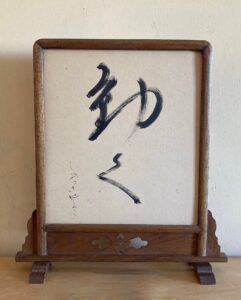
Chanoyu can be presented almost anywhere. In a room or outside. Cha-dō-gu, 茶道具, tea-way-tools, are carried to the place where Tea is to be prepared. Carrying anything can be called hakobi, 運び, carry. In a Tea-room, the fire that is needed to make hot water for tea is held in a portable brazier called a fu-ro, 風炉, wind-hearth, or in a permanent hearth set in the floor called a ro, 炉, hearth. The water is heated in a kama, 釜, kettle.
In Japanese beliefs, fire must have a permanent place, so that the ‘fire-god’ will ‘know’ where to lite. Hence, the permanent ro, a hearth sunk in the floor of the Tearoom. However, if Tea is to be presented where there is no ro, the furo can be used. This applies especially when presenting Tea outside. Exceptions include a fire pit in the ground. An important issue is having hot water, and how to make it. Japanese traditionally use charcoal, sumi, 炭. Because there are concerns about an open charcoal fire, many people use electric burners to heat water.
The furo is carried to the place where Tea is to be presented, which happened before the guests arrival. The early furo, originating in China, where often made of iron, tetsu bu-ro, 鉄風炉, iron wind-hearth. The kama, 釜, kettle, rests on the upright collar of the furo. Many furo had loose, ring handles, kan-tsuki, 鐶付き, metal ring-attach, that were intended to be used to transport the furo. The loose rings allowed the furo to be moved without burning one’s hands holding the bowl of the hot furo. In Tea, for several reasons, it is customary to NOT carry a furo holding the rings.
The rings attached on both sides of the furo are held in the mouths of so-called ki-men, 鬼面, demon-mask, which give these special furo the name ki-men bu-ro, 鬼面風炉, demon-mask wind-hearth. Loose rings are set upright resting against the furo when there is a fire within, and are let hang down when there is no fire within. With some mizu-sashi, 水指, water-indicate, cold water vessels that have rings at the sides, the rings are always left hanging. ‘Rings up’ manifests the principle of Yō, 陽, Yang, positive, penetrative, ‘rings down’ manifest the complimentary principle of In, 陰, Yin, negative, receptive. These concepts are true for any Tea presentation, regardless of the nature of the furo.
The word furo meaning ‘wind hearth’, may prompt a question as to why there is a reference to wind. Wind isn’t wind unless it moves, ugoku, 動く, therefore, the ‘wind’ of the furo may refer to its being portable, hakobi. Because belief insists that fire has a fixed place, the furo is set in the Tearoom before the guests enter the room.
Having the furo set in the Tearoom for the plainest Tea presentation of hakobi usu-cha ten-mae, 運び薄茶点前, carry thin-tea offer-fore, the first Tea utensil brought into the room is the mizu-sashi, 水指, water-indicate. In a Tea presentation that uses a display stand, tana, 棚, shelf, or dai-su, 台子, support-of, the mizusashi is usually displayed before the guests enter. The upper shelf of the stand, which is called ten-ita, 天板, heaven-board, is for the display of the cha-ki, 茶器, tea-container.
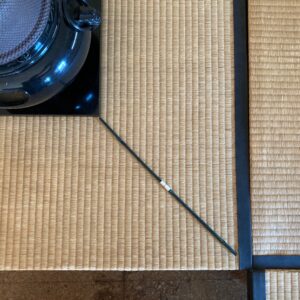
Naka-oki, 中置, middle-place: the fu-ro, 風炉, wind-hearth, is placed in the middle of the han-jō, 半畳, half-mat, equidistant from each edge. The hanjō tatami pictured is Kyō-ma, 京間, Capital-room, which measures 2.5 shaku kujira-jaku, or 3.125 shaku kane-jaku.
The width of the black-lacquered shiki-ita, 敷板, spread-board, is 9.5 sun kane-jaku. The distance between the near right corner of the board and the inside of the heri, 縁, edging, is 14 sun kane-jaku, as illustrated by the black stick that measures 14 sun kane-jaku. The white strip marks the 7 sun kane-jaku, center. This is true of each of the four corners. In most Tea presentations, 14 sun kane-jaku is the space allotted for the width of the teishu.
In October, Tea may be presented with the furo placed in the middle of the ten-mae tatami, 点前畳, offer-fore mat. This Tea presentation is called Naka-oki, 中置, Middle-place. For this presentation, the mizusashi is the first utensil carried into the Tearoom. There are more formal Tea presentations in which the furo is placed on the ji-ita, 地板, earth-board, in the middle of the dai-su, 台子, support-of, a mizusashi is displayed on the daisu left of the furo.
The Nakaoki Tea presentation with the furo placed in the middle of the dōgu tatami, affirms its identity with the Buddhist kō-ro, 香炉, incense-hearth, that is displayed in the middle of the Butsu-dan, 仏壇, Buddhist-altar. Nakaoki is presented in October, which in Japan is called Kan-na-zuki, 神無月, God-less-month, because in the tenth month, Shintō deities assemble at Izumo Tai-sha, 出雲大社, Out-cloud Great-shrine. The Buddhist deities remain in their shrines and temples. The Nakaoki presentation with the furo in the center of the tatami is like an incense burner on Buddhist altars. The specific Buddhist deity that would be most revered in the Nakaoki presentation may be A-mi-da Nyo-rai, 阿弥陀如来, Praise-increase-steep Like-become.
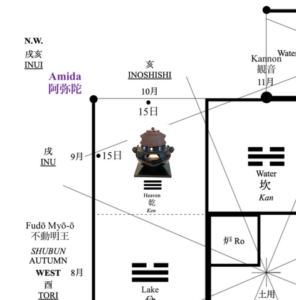
According to the Eki-kyō, 易経, Change-sutra, and Asian geomancy, the northwest and the northwest corner of the yo-jō-han, 四畳半, four-mat-half, Tearoom where the Tea is prepared, is protected by Amida. This is emphasized by the tradition of venerating Amida on his En-nichi, 縁日, Edge-day, which is the 15th day of each month.
The northwest is identified with the Asian zodiac animals Inu, 戌, Dog, and I, 亥, Boar: Inu-I, 乾, dry, heaven. The Tearoom walls on the northwest corner are also identified with the 9th and 10th lunar months, which correspond approximately with the half-tatami width of the corner han-jō, 半畳, half-tatami. Extending inward, the 15th day of the 9th and 10th lunar months cross in the center of the hanjō. Thus, it seems that the joining of two separate days identified with Amida that the furo/kōro may be identified with Amida.
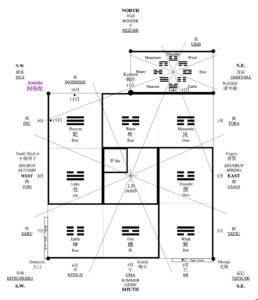
Diagram of yo-jō-han, 四畳半, four-mat-half, showing locations of various Buddhist deities. Amida is located in the northwest, upper left corner of the room. The placement of the ha-kke, 八卦, eight-signs, of the Eki-kyō, 易経, Change-sutra, are located in the eight outer half-mat tatami that surround the central half-mat, which is identified with Earth.

The sen-zara is used in very formal Tea presentations to support and carry into the Tearoom the shin chakin and the chasen. The diameter of the senzara is 4 sun kujira-jaku. The size of the shin chakin is one shaku or 8 sun kujira-jaku square. The shin chakin existed before the senzara, which was specifically made to support the chakin and the chasen. It is likely that an existing dish was chosen to carry the chakin and the chasen. A possible choice was a particular dish used in Buddhist meal service called a tsubaki-zara, 椿皿, camellia-dish.
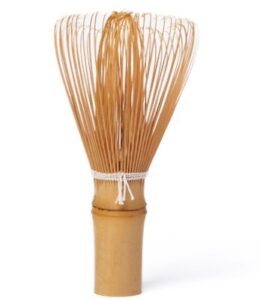
Cha-sen, 茶筅, tea-whisk, bamboo with white thread; L. 3.75 sun kane-jaku or 3 sun kujira-jaku. The whisk is used in very formal Tea offerings. For sacred tea offerings, the whisk is wound with white thread. Very formal domestic Tea presentations do not use a whisk with white thread. It is exceedingly important to comprehend carrying the chasen and chakin on a dish to begin a Tea presentation of offering.
The form of the chasen is primarily a triangle, san-kaku, 三角, three-corner. This refers to the outer tines. Yet, there is another triangle – the inner tines of the chasen. The chasen as pictured is in its resting stage, so that the triangle of the whisk is pointing down, which is also the bamboo’s growth direction. The inner triangle is pointing up, but when it is used to whisk tea, its true purpose, the triangle is pointing down. The triangle is a manifestation of sue-hiro, 末広, ends-wide, which is symbolic of Infinity in Space.
Ō-nusa, 大幣, large-cloth offering, streamers made of asa, 麻, hemp, attached to a stick made of hinoki, 檜, cypress, wood, erected in its stand.
The chakin and the chasen may be likened to offerings made at Shintō shrines. The chakin is made of asa, 麻, hemp, and Amaterasu is a weaver of hemp cloth. At a Shintō shrine, purification is enacted using a kind of soft flail called an ō-nusa, 大幣, large-cloth offering, which is a bundle of dried and prepared hemp strips attached to a stick that is made of wood or bamboo. The ōnusa as a purifier is called a harae-gushi, 祓串, exorcise-skewer, which is displayed at the front of the shrine standing upright in a holder. An alternative to the hemp fibers, cut paper shi-de, 紙垂, paper-hang, streamer, (also shi-de, 四手, four-hand).
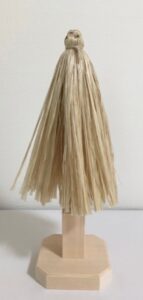
The comparisons between the chasen and the ōnusa are manifestations of In and Yō, Ying and Yang, 陰 and 陽, negative and positive. Both are moved: one in water/tea, and one in the air. The whisk tines are rigid and upright, the hemp fibers are flexible and hang down. The whisk is wet, the hemp is dry.
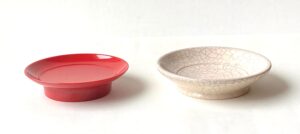
Left: sen-zara, 筅皿, whisk-dish, white ceramic with kan-nyū, 貫入, penetrate-into, crackle glaze, by Yoshi-mura Raku-nyū, 吉村楽入, Luck-field Pleasure-enter; diam. 5 sun kane-jaku, or 4 sun kujira-jaku. Right: tsubaki-zara, 椿皿, camellia-dish, red plastic; diam. 4.4 sun kane-jaku, or 3.52 sun kujira-jaku. The tsubaki-zara originated in Buddhist meal service to hold food.
The senzara is traditionally made of white Raku with crackle glaze, kan-nyū, 貫入, penetrate-into, although I have not been successful in finding its origins. The senzara is round, and the circle is emblematic of Water. The chakin is square, which is emblematic of Earth. The chasen is triangular, and the triangle is emblematic of Fire.
Buddhist meal service is traditionally made of wooden bowls and plates with shu-nuri, 朱塗, vermillion-lacquer. Perhaps, the choice of a white senzara was to complement the red tsubaki-zara. The color white is believed to be Yō, 陽, Yang, positive, masculine, male, semen, and the color red is believed to be In, 陰, Yin, negative, feminine, female, blood.

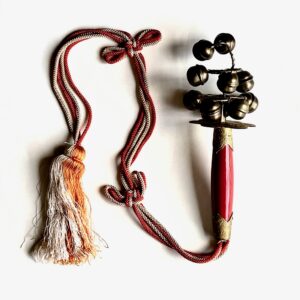
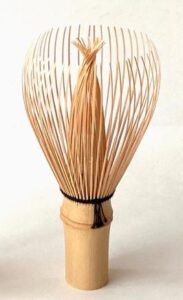
Red and white are epitomized in the garb of Shintō shrine maidens called mi-ko, 巫女, medium-woman, a kind of shaman. She wears a white kimono-like garment, a pair of red hakama, 袴, ‘culottes’, and a light weight white jacket, chi-haya, 千早, thousand-early. The young woman depicted is ringing a cluster of bells, suzu, 鈴, to summon the deities. The bells are a means of uniting humanity with the kami, 神, divine spirits. One of the roles of the miko roles is to dance. Shintō sacred dance is called kagura, 神楽, god-pleasure. The miko represents the goddess, Ame-no-uzu-me, 天之鈿女, Heaven-’s-narrow-woman, who danced before ame-no-iwa-to, 天の岩戸, heaven’s rock door, to coax out Ama-terasu, 天照, Heaven-brightener, the sun goddess. Rather than bells, during her dance, Amenouzume brandished a cluster of grasses, susuki, 芒, eulalia. Dance is surely a form of movement. In Shintō rites, the cluster of suzu is twisted to make the bells ring. Perhaps the suzu bells may be likened to the chasen.
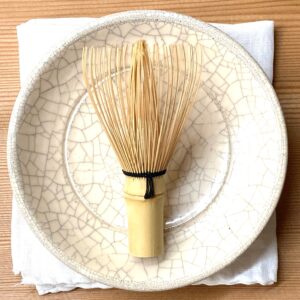
Cha-sen, 茶筅, tea-whisk, take, 竹, bamboo, by Tani-mura Tan-go, 谷村丹後, Valley-town Red-after; L. 3 sun kujira-jaku. Sen-zara, 筅皿, whisk-dish, ceramic with kan-nyū, 貫入, penetrate-into, crackle glaze, by Yoshi-mura Raku-nyū, 吉村楽入, Luck-field Pleasure-enter; diam. 5 sun kane-jaku, placed on a folded shin cha-kin, 真茶巾, true tea-cloth, asa, 麻, hemp; fully opened the chakin is 8 x 8 sun kujira-jaku [hemmed].
The darkened crackled glaze gives the impression that it is old, and has been excavated from the earth.
The sen-zara, 筅皿, whisk-dish, and the shin cha-kin, 真茶巾, true tea-cloth, are manifestations of two of the three basic shapes: circle and square. The circle is symbolic of the principle of In, 陰, Yin, receptive, negative, and the square is symbolic of Yō, 陽, Yang, penetrative, positive. The form of the chasen is triangular, with its flared tines. Thus, the three prime shapes of circle, square, and triangle are present, and they represent the world.
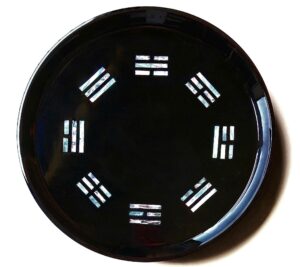
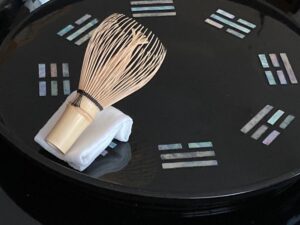
Ha-kke bon, 八卦盆, eight-sign tray, black-lacquered wood with shell inlay of the eight trigrams of the Eki-kyō, 易経, Change-sutra. Right: cha-sen, 茶筅, tea-whisk, and cha-kin, 茶巾, tea-cloth, placed on the trigram, ☲, Ri, 離, Separation, which represents Fire. Tea utensils are placed on the trigrams, which reveals their identity. The chasen and chakin are placed on the front, middle trigram Ri, 離, Detach, which is also identified with Fire. Therefore, the chakin and the chasen are imbued with Fire, which causes change.
The Hakke Bon, 八卦盆, Eight-divination sign Tray, is a round, black-lacquered wood tray with a raised edge, and decorated with designs of the eight divinations signs of the Eki-kyō, Chinese I-Ching, Change-sutra. It has a diameter of 8.8 sun kujira-jaku, a number that is identified with Infinity in Space. The tray is used in the presentation of Gyō-no-gyō Daisu no Tenmae, 行之行台子点前, Transition-’s-transition Support-of-’s Offer-fore. The utensils for the preparation of the tea are placed on the appropriate divination sign that identifies the nature of the utensil. Most of the utensils for the Tea presentation are displayed on the tray on the heaven-board, before the guests enter the Tearoom.
The hakke bon trigrams, 三卦, three-sign, shown in the picture above from 12:00 clockwise are: Kan, 坎, Water, Gon, 艮, Mountain, Shin, 震, Thunder, Son, 巽, Wind, Ri, 離, Fire, Kon, 坤, Earth, Da, 兌, Lake, Ken, 乾, Heaven.
Formal Tea Presentation – detail.
To begin a very formal Tea presentation, the tei-shu, 亭主, house-master, sits before the cha-dō guchi, 茶道口, tea-way opening, with the chasen and chakin on the senzara to the side, slides open the door, bows in unison with the guests, and carries the senzara into the Tearoom, and closes the door. Sitting in front of the dai-su, 台子, support-of, the teishu places the senzara on the tatami in front of the hi-mado, 火窓, fire-window, of the fu-ro, 風炉, wind-hearth. This location is called hi-mado mae, 火窓前, fire-window fore. Placing the senzara in front of the furo himado, in a way, approximates displaying the chakin and chasen on the hakke-bon trigram, ☲, Ri, 離, Separation, which represents Fire.
As the chakin and chasen are identified with Fire, according to their placement of the trigram for Fire on the hakke bon, the teishu carrying the senzara with the chakin and chasen, is metaphorically carrying fire. It should be remembered that the Kanji for tei-shu, 亭主, house-master, the Kanji for shu, 主, is based on a candle stand. The lower part of the Kanji, ō, 王, means king. The dot, ten, 丶, on top means fire, however, it represents ten, 點, which is the Kanji used for Tea presentation called ten–mae, 點前, offer-fore.
Rikyū’s ideal chashitsu is the yojōhan, and it is the appropriate room in which to present a very formal Tea presentation. The tokonoma is in the north toward the east. The guests sit in the east facing west. The nijiri-guchi is in the south toward the east, opposite the tokonoma. The Tea is presented in the west, and the utensils are arranged in the northwest corner of the room. The chadō-guchi is in the west wall toward the south. Therefore, when the teishu enters the yojōhan, he or she leaves the west, moves toward the east, turns and proceeds to the north and the Tea utensils. The senzara is placed in front of the furo – the location, himado mae, is also called the Ten-moku-za, 天目座, Heaven-eye-seat, which is the place where the Tenmoku chawan rests containing hot water and the chasen.
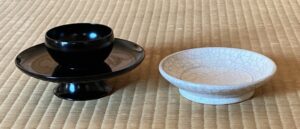
Ten-moku cha-wan dai, 天目茶碗台, heaven-eye tea-bowl support, black-lacquered turned wood stand, hane, 羽, wing, diam. 5.5 sun kane-jaku. Sen-zara, 筅皿, whisk-dish, white ceramic dish with crackled glaze, 貫入, penetrate-into, diam. 5 sun kane-jaku. The diameters of the two utensils relate to each other 10 to .9090909 to infinity. The number 9 is richly symbolic, e.g., the 9 half-mat yojōhan chashitsu, and is the basis of many Buddhist mandalas.
The chasen is emblematic of Fire, the chakin is identified with Fire, according with the Ekikyō. The round senzara circle, symbolic of Water, metaphorically ‘protects’ the hands of the teishu against the Fire of the chasen and chakin. In Tea presentations when the chawan with the chasen, chakin, and chashaku, the manner is modeled on that of carrying the senzara in a formal Tea presentation. The teishu carries Fire – from Amida’s radiant western paradise of Jō-do, 浄土, Pure-land.
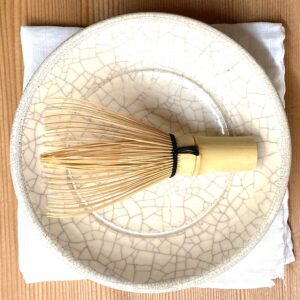
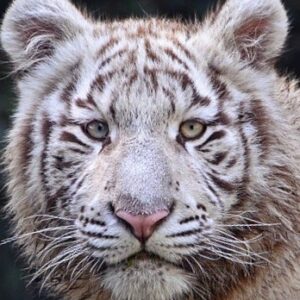
According to ancient Asian geomancy, the twenty-eight celestial constellations are divided into groups of seven, that are located in the four directions, and given identifying beings called the Shi-jin, 四神, Four-gods. This system originated in ancient Chinese Taoism. North – Gen-bu, 玄武, Black-warrior; East – Sei-ryū, 青龍, Blue-green-dragon; South – Su-zaku, 朱雀, Vermilion-sparrow; West – Bya-kko, 白虎, White-tiger. Perhaps the senzara is white because it originates in the west, like the White Tiger. If such a comparison can be drawn, the tea whisk could be seen as the tiger whiskers.
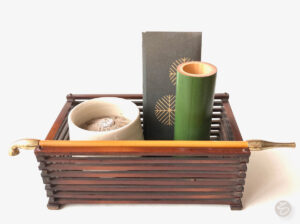
Symbolism and metaphor aside, the teishu does, in actuality, carry fire. In a holder of course. After serving koi-cha, 濃茶, thick-tea, and preparing to serve usu-cha, 薄茶, thin-tea, the tei-shu rebuilds the sumi-bi, 炭火, charcoal-fire, in the furo or ro, which is called go-zumi, 後炭, latter-charcoal. The burning pieces of charcoal in the hearth are manipulated, motsu, 持つ, handle, with metal hi-bashi, 火箸, fire-rods, but not really carried. While waiting for the fire to heat the water in the kettle until it makes the sound of matsu-kaze, 松風, pine-wind, indicating that the temperature is appropriate for making tea, the teishu carries into the Tearoom a tabako bon, 煙草盆, burn-grass tray, indicating a time for relaxation. The teishu places the tabako bon in front of the shō-kyaku, 正客, main-guest, so that the guest can handle fire in the form of the tobacco. Both bow.
The host and guest have a conversation. The tabako bon has within it a cup, hi-ire, 火入, fire-receptacle, filled with wood ash, containing a small piece of burning charcoal, kō-ta-don, 香炭団, incense-charcoal-ball. Also included in the tray is a length of green bamboo called a hai-fuki, 灰吹, ash-blow, that contains a small amount of water to extinguish burnt ash. A balance of fire and water. Other things in the tabako bon may include a kiseru, 煙管, tobacco-tube, and tobacco in a paper envelope, tabako-ire, 煙草入, tobacco-container. The teishu does indeed carry fire. It should be remembered that the Kanji for shu, 主, in tei-shu, 亭主, house-master, means ‘master of fire’. By presenting the tabako bon to the guest, the teishu allows the guest to handle the hiire containing the burning charcoal, and the burning tobacco when smoking, so that the guest becomes ‘master of fire’.
For Further study, see also: Hakobi Tenmae: Carry Water, October and Nakaoki, Tabako Bon and the Five Elements, and Shijinjū

